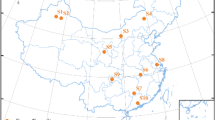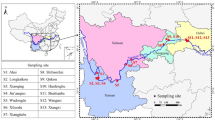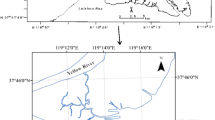Abstract
In this study, we examined three horizontal and vertical soil profiles along a sewage drainage ditch in order to determine the spatial distribution of Cu, Pb, and Zn in soils and to assess the bioavailability and potential ecological risks associated with these metals in a potential groundwater source area. Results showed that the concentrations of Cu, Pb, and Zn were approximately at background level, suggesting that human activities (industrial and agricultural pollution) had a negligible influence on these metals in soil, and that the concentrations reflected the natural background levels in the study area. Cu, Pb, and Zn concentrations were slightly higher in topsoil (0–20 cm) than deeper in the soil profile. Using a modified BCR sequential extraction method to evaluate the mobility and bioavailability of metals showed that the potential bioavailability sequence of Cu, Pb, and Zn at three depths in the soil profile was in the order Cu ≈ Pb < Zn. The potential ecological risk from the metals was evaluated using risk assessment code, and the results suggest that Cu and Zn pose no or low risk, while there is a low or medium risk from Pb. Results from groundwater monitoring showed that the groundwater was not polluted by leaching from soil.







Similar content being viewed by others
References
Al-Khashman, O., & Shawabkeh, R. A. (2006). Metals distribution in soils around the cement factory in southern Jordan. Environmental Pollution, 140, 387–394.
Alumaa, P., Kirso, U., Petersell, V., & Steinnes, E. (2002). Sorption of toxic heavy metals to soil: short communication. International Journal of Hygiene and Environmental Health, 204, 375–376.
Álvarez, E., Fernández-Marcos, M. L., Vaamonde, C., & Fernández-sanjurjo, M. J. (2003). Heavy metals in the dump of an abandoned mine in Galicia (NW Spain) and in the spontaneously occurring vegetation. Science of the Total Environment, 313(1–3), 189–197.
Bowen, H. T. M. (1979). Environmental chemistry of the elements. London: Acad Press.
Chen, C., Lu, Y., Hong, J., Ye, M., Wang, Y., & Lu, H. (2010). Metal and metalloid contaminant availability in Yundang Lagoon sediments, Xiamen Bay, China, after 20 years continuous rehabilitation. Journal of Hazardous Materials, 175(1–3), 1048–1055.
Cuong, D. T., & Obbard, N. (2006). Metal speciation in coastal marine sediments from Singapore using a modified BCR sequential extraction procedure. Applied Geochemistry, 21, 1335–1346.
Delgado, J., Barba-Brioso, C., Nieto, J. M., & Boski, T. (2011). Speciation and ecological risk of toxic elements in estuarine sediments affected by multiple anthropogenic contributions (Guadiana salt marshes, SW Iberian Peninsula): I. Surficial sediments. The Science of the Total Environment, 409, 3666–3679.
Franklin, R. E., Duis, L., Brown, R., & Kemp, T. (2005). Trace element content of selected fertilizers and micronutrient source materials. Soil Science and Plant Analysis, 36, 1591–1609.
Ghrefat, H. A., Yusuf, N., Jamarh, A., & Nazzal, J. (2012). Fractionation and risk assessment of heavy metals in soil samples collected along Zerqa River, Jordan. Environmental Earth Sciences, 66, 199–208.
Guillén, M. T., Delgado, J., Albanese, S., & Nieto, J. M. (2012). Heavy metals fractionation and multivariate statistical techniques to evaluate the environmental risk in soils of Huelva Township (SW Iberian Peninsula). Journal of Geochemical Exploration, 119–120, 32–43.
He, Z. L., Yang, X. E., & Stoffella, P. J. (2005). Trace elements in agroecosystems and impacts on the environment. Journal of Trace Elements in Medicine and Biology, 19, 125–140.
Herbert, R. B. (1997). Partitioning of heavy metals in soils contaminated by mine drainage water, Dalarne, Sweden. Water, Air, and Soil Pollution, 96, 39–59.
ISO (1998). Soil quality—determination of organic carbon by sulfochromic oxidation. ISO 14235,1998.
ISO (2005). Soil quality—determination of pH. ISO 10390, 2005.
ISO (2007). Soil quality -- Determination of effective cation exchange capacity (CEC) and exchangeable cations using a hexamminecobalt trichloride solution. ISO 23470.
Jain, C. K. (2004). Metal fractionation study on bed sediments of River Yamuna, India. Water Research, 38, 569–578.
Jain, C. K., Singhal, D. C., & Sharma, M. K. (2004). Adsorption of zinc on bed sediment of River Hindon: adsorption models and kinetics. Journal of Hazardous Materials, B114, 231–239.
Jain, C. K., Gupta, H., & Chakrapani, G. J. (2008). Enrichment and fractionation of heavy metals in bed sediments of River Narmada, India. Environmental Monitoring and Assessment, 141, 35–47.
Jalali, M., & Khanboluki, G. (2008). Redistribution of zinc, cadmium, and lead among soil fractions in a sandy calcareous soil due to application of poultry litter. Environmental Monitoring and Assessment, 136, 327–335.
Kabata-Pendias, A. (2010). Trace elements in soils and plants (4th ed.). Boca Raton: CRC Press.
Kabata-Pendias, A., & Mukherjee, A. B. (2007). Trace elements from soil to human. New York: Springer.
Kartal, S., Aydin, Z., & Tokalioğlu, S. (2006). Fractionation of metals in street sediment samples by using the BCR sequential extraction procedure and multivariate statistical elucidation of the data. Journal of Hazardous Materials, 132, 80–89.
Kot, A., & Namiesnik, J. (2000). The role of speciation in analytical chemistry. Trends in Analytical Chemistry, 19, 69–79.
Kubová, J., Matúš, P., Bujdoš, M., Hagarová, I., & Medved, J. (2008). Utilization of optimized BCR three-step sequential and dilute HCl single extraction procedures for soil-plant metal transfer predictions in contaminated lands. Talanta, 75, 1110–1122.
Lei, M., Zhang, Y., Khan, S., Qin, P. F., & Liao, B. H. (2010). Pollution, fractionation, and mobility of Pb, Cd, Cu and Zn in garden and paddy soils from a Pb/Zn mining area. Environmental Monitoring and Assessment, 168, 215–222.
Leleyter, L., & Probst, J. L. (1999). A new sequential extraction procedure for the speciation of particulate trace elements in river sediments. International Journal of Environmental Analytical Chemistry, 73, 109–128.
McBride, M. B. (1994). Environmental chemistry of soils. New York: Oxford University Press.
Miller, D. M., Sumner, M. E., & Miller, W. P. (1989). A comparison of batch-generated and flow-generated anion adsorption-isotherms. Soil Science Society of America Journal, 53, 373–380.
Miretzky, P., Avendaño, M. R., Muñoz, C., & Carrillo-Chavez, A. (2011). Use of partition and redistribution indexes for heavy metal soil distribution after contamination with a multi-element solution. Journal of Soils and Sediments, 11, 619–627.
Nouri, J., Mahvi, H., Jahed, G. R., & Babaei, A. A. (2008). Regional distribution pattern of groundwater heavy metals resulting from agricultural activities. Environmental Geology, 55, 1337–1343.
Pérez, G., López-Mesas, M., & Valiente, M. (2008). Assessment of heavy metals remobilization by fractionation: comparison of leaching tests applied to roadside sediments. Environmental Science and Technology, 42, 2309–2315.
Perin, G., Craboledda, L., Lúchese, M., Cirillo, R., Dotta, L., Zanette, M. L., & Orio, A. A. (1985). Heavy metal speciation in the sediments of Northern Adriatic Sea—a new approach for environmental toxicity determination. In T. D. Lekkas (Ed.), Heavy metal in the environment (pp. 454–456).
Pichtel, J., Sawyerr, H. T., & Czarnowska, K. (1997). Spatial and temporal distribution of metals in soils in Warsaw, Poland. Environmental Pollution, 98, 169–174.
Rauret, G., Lopez-Sanchez, J. F., Sahuquillo, A., Rubio, R., Davidson, C., Ure, A., & Quevauviller, P. (1999). Improvement of the BCR three step sequential extraction procedure prior to certification of new sediment and soil reference materials. Journal of Environmental Monitoring, 1, 57–61.
Rodríguez, L., Ruiz, E., Alonso-Azcárate, J., & Rincón, J. (2009). Heavy metal distribution and chemical speciation in tailing and soils around a Pb-Zn mine in Spain. Journal of Environmental Management, 90, 1106–1116.
Rule, J. H. (1999). Trace metal cation adsorption in soils: selective chemical extractions and biological availability. In Dabrowski (Ed.), Adsorption and its applications in industry and environmental protection (pp. 319–349). Amsterdam: Elsevier.
Sahuquillo, A., Lopez-Sanchez, J. F., Rubio, R., Rauret, G., Thomas, R. P., Davidson, C. M., & Ure, A. M. (1999). Use of a certified reference material for extractable trace metals to assess sources of uncertainty in the BCR three-stage sequential extraction procedure. Analytica Chimica Acta, 382, 317–327.
Singh, K. P., Mohan, D., Singh, V. K., & Malik, A. (2005). Studies on distribution and fractionation of heavy metals in Gomti river sediments—a tributary of the Ganges, India. Journal of Hydrology, 312, 14–27.
Sundaray, S. K., Nayak, B. B., Lin, S., & Bhatta, D. (2011). Geochemical speciation and risk assessment of heavy metals in the river estuarine sediments—a case study: Mahanadi basin, India. Journal of Hazardous Materials, 186(2–3), 1837–1846.
Sutherland, R. A. (2002). Comparison between non-residual Al, Co, Cu, Fe, Mn, Ni, Pb and Zn released by a three-step sequential extraction procedure and a dilute hydrochloric acid leach for soil and road deposited sediment. Applied Geochemistry, 17, 353–365.
Tao, J. S., & Liu, Y. (2000). Evaluation of chemical quality of soil environment of Ningxia. Ningxia Science and Technology of Agriculture and Foresty, 2, 17–21 (in Chinese with English Abstract).
Thomson, L. M., & Frederick, R. R. (2002) Soils and fertility. McGraw-Hill. Ed. Reverte.
Tokalioğlu, S., & Kartal, S. (2005). Comparison of metal fractionation results obtained from single and BCR sequential extractions. Bulletin of Environmental Contamination and Toxicology, 75, 180–188.
Tran, Y. T., Bajracharya, K., & Barry, D. A. (1998). Anomalous cadmium adsorption in flow interruption experiments. Geoderma, 84, 169–184.
Ure, A. M., Quevauviller, P., Muntau, H., & Griepink, B. (1993). Speciation of heavy metals in soils and sediments. An account of the improvement and harmonization of extraction techniques undertaken under the auspices of the BCR of the Commission of the European Communities. International Journal of Environmental Analytical Chemistry, 51, 135–151.
USEPA. (2009). In R. E. Cameron (Ed.), Guide to site and soil description for hazardous waste site characterization. Environmental Protection Agency: United States of America.
Vaněk, A., Borůvka, L., Drábek, O., Mihaljevič, M., & Komárek, M. (2005). Mobility of lead, zinc and cadmium in alluvial soils heavily polluted by smelting industry. Plant, Soil and Environment, 51(7), 316–321.
Wei, F., Zheng, C., Chen, J., & Wu, Y. (1991). Study on the background contents on 61 elements of soils in China. Chinese Journal of Environmental Science, 12, 12–19 (in Chinese with English Abstract).
Zemberyová, M., Barteková, J., & Hagarová, I. (2006). The utilization of modified three-step sequential extraction procedure for the fractionation of Cd, Cr, Cu, Ni, Pb and Zn in soil reference materials of different origins. Talanta, 70, 973–978.
Acknowledgments
This study was supported by the National Key Scientific and Technological Project of China (No. 2014ZX07201-010) and Natural Science Fundation of China (No. 41473086).
Author information
Authors and Affiliations
Corresponding author
Rights and permissions
About this article
Cite this article
Teng, Y., Feng, D., Wu, J. et al. Distribution, bioavailability, and potential ecological risk of Cu, Pb, and Zn in soil in a potential groundwater source area. Environ Monit Assess 187, 293 (2015). https://doi.org/10.1007/s10661-015-4541-3
Received:
Accepted:
Published:
DOI: https://doi.org/10.1007/s10661-015-4541-3




